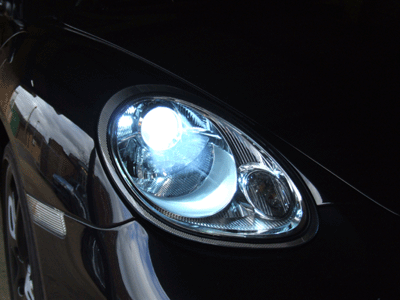HID ! Xenon ! Zenon ! …. ?
Porsche Cayman & Boxster 987 gets brighter! Design 911 can now fit HID Xenon lamps to the newer Porsche models, cars which are manufactured after 2005. The new kit system will retro fit all the cars using a new special design of control unit.
Â
It general takes us about 2 hours to fit this new design kit.
Â
What is HID Xenon?
High Intensity Discharge (HID) Xenon headlights are the new generation headlights that are fitted to most luxury cars and most new cars can have them fitted as an (expensive) option. They produce 300% more light than standard halogens and yet use less power. The HID Xenon (not Zenon) lighting technology is significantly different to the conventional halogen bulbs that use a heated tungsten filament. Unlike Halogen lamps, HID lamps don’t have a filament but create light as a result of an arc between two electrodes. The heat from the arc vaporizes the metal halide which produces light as the temperature and pressure increases. The light produced by an HID Xenon lighting system is greater than a standard halogen bulb and with less power consumption. On the road, HID Xenon lighting systems appear as a bright white beam which resembles natural daylight. The bright white beam offers greater visibility and road safety.
Â
What is Kelvin (K) and what’s the difference between 4300, 6000 and 8000K?
The K (Kelvin) Temperature range is a basic unit of thermodynamic temperature (colour temperature) used to measure the whiteness of the light output. The higher the number is, the whiter the light is. When fitting over 5000K the light begins to turn to blue as daylight.
There are only really 4 colours of HID available, despite the claim of sellers and manufacturers to the contrary. These are Standard factory 4300K (yellowish white), 5000K crystal white with no blue tint, 6000 crisp white light with delicate to moderate blue tint, and 8000K strong blue light. The highest light output is 4300K and the lowest 8000K.
OEM is 4300K and without a question gives the most amount of light. I have tested dozens of bulbs and compared them all to a Philips D2S bulb as a reference point. The difference between colours and manufacturers is really quite shocking. The best 6000K bulb produced 15% less light than the Philips 4300K – while the worst 6000K bulb was a dreadful 70% less. That said, our bulbs being the best ones with 15% less light in measurable terms, actually produce a very white light with a slight blue tint when you look at them. For every day driving this really is a more pleasant light than the yellowish 4300K. As its whiter light is more pleasant and in most driving conditions appears brighter. The reflection from signs and white lines is far better with the 6000K.
